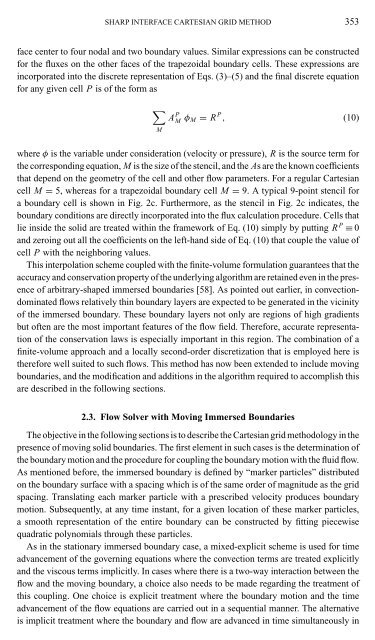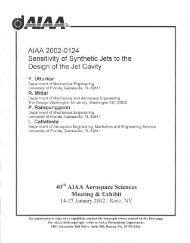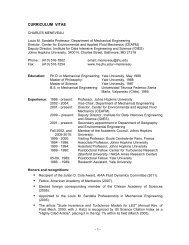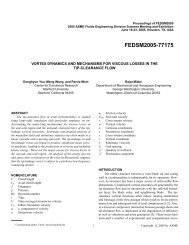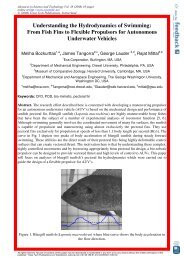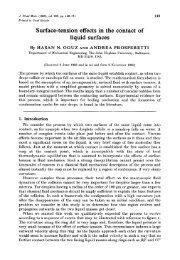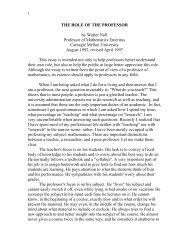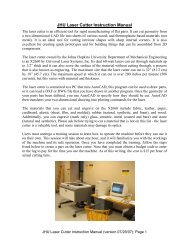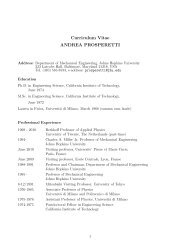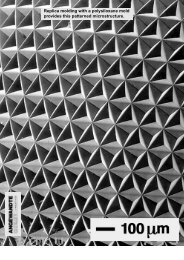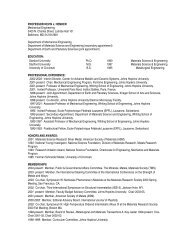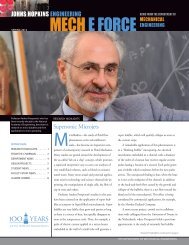A Sharp Interface Cartesian Grid Method for Simulating Flows with ...
A Sharp Interface Cartesian Grid Method for Simulating Flows with ...
A Sharp Interface Cartesian Grid Method for Simulating Flows with ...
Create successful ePaper yourself
Turn your PDF publications into a flip-book with our unique Google optimized e-Paper software.
SHARP INTERFACE CARTESIAN GRID METHOD 353<br />
face center to four nodal and two boundary values. Similar expressions can be constructed<br />
<strong>for</strong> the fluxes on the other faces of the trapezoidal boundary cells. These expressions are<br />
incorporated into the discrete representation of Eqs. (3)–(5) and the final discrete equation<br />
<strong>for</strong> any given cell P is of the <strong>for</strong>m as<br />
∑<br />
AM P φ M = R P , (10)<br />
M<br />
where φ is the variable under consideration (velocity or pressure), R is the source term <strong>for</strong><br />
the corresponding equation, M is the size of the stencil, and the As are the known coefficients<br />
that depend on the geometry of the cell and other flow parameters. For a regular <strong>Cartesian</strong><br />
cell M = 5, whereas <strong>for</strong> a trapezoidal boundary cell M = 9. A typical 9-point stencil <strong>for</strong><br />
a boundary cell is shown in Fig. 2c. Furthermore, as the stencil in Fig. 2c indicates, the<br />
boundary conditions are directly incorporated into the flux calculation procedure. Cells that<br />
lie inside the solid are treated <strong>with</strong>in the framework of Eq. (10) simply by putting R P ≡ 0<br />
and zeroing out all the coefficients on the left-hand side of Eq. (10) that couple the value of<br />
cell P <strong>with</strong> the neighboring values.<br />
This interpolation scheme coupled <strong>with</strong> the finite-volume <strong>for</strong>mulation guarantees that the<br />
accuracy and conservation property of the underlying algorithm are retained even in the presence<br />
of arbitrary-shaped immersed boundaries [58]. As pointed out earlier, in convectiondominated<br />
flows relatively thin boundary layers are expected to be generated in the vicinity<br />
of the immersed boundary. These boundary layers not only are regions of high gradients<br />
but often are the most important features of the flow field. There<strong>for</strong>e, accurate representation<br />
of the conservation laws is especially important in this region. The combination of a<br />
finite-volume approach and a locally second-order discretization that is employed here is<br />
there<strong>for</strong>e well suited to such flows. This method has now been extended to include moving<br />
boundaries, and the modification and additions in the algorithm required to accomplish this<br />
are described in the following sections.<br />
2.3. Flow Solver <strong>with</strong> Moving Immersed Boundaries<br />
The objective in the following sections is to describe the <strong>Cartesian</strong> grid methodology in the<br />
presence of moving solid boundaries. The first element in such cases is the determination of<br />
the boundary motion and the procedure <strong>for</strong> coupling the boundary motion <strong>with</strong> the fluid flow.<br />
As mentioned be<strong>for</strong>e, the immersed boundary is defined by “marker particles” distributed<br />
on the boundary surface <strong>with</strong> a spacing which is of the same order of magnitude as the grid<br />
spacing. Translating each marker particle <strong>with</strong> a prescribed velocity produces boundary<br />
motion. Subsequently, at any time instant, <strong>for</strong> a given location of these marker particles,<br />
a smooth representation of the entire boundary can be constructed by fitting piecewise<br />
quadratic polynomials through these particles.<br />
As in the stationary immersed boundary case, a mixed-explicit scheme is used <strong>for</strong> time<br />
advancement of the governing equations where the convection terms are treated explicitly<br />
and the viscous terms implicitly. In cases where there is a two-way interaction between the<br />
flow and the moving boundary, a choice also needs to be made regarding the treatment of<br />
this coupling. One choice is explicit treatment where the boundary motion and the time<br />
advancement of the flow equations are carried out in a sequential manner. The alternative<br />
is implicit treatment where the boundary and flow are advanced in time simultaneously in


